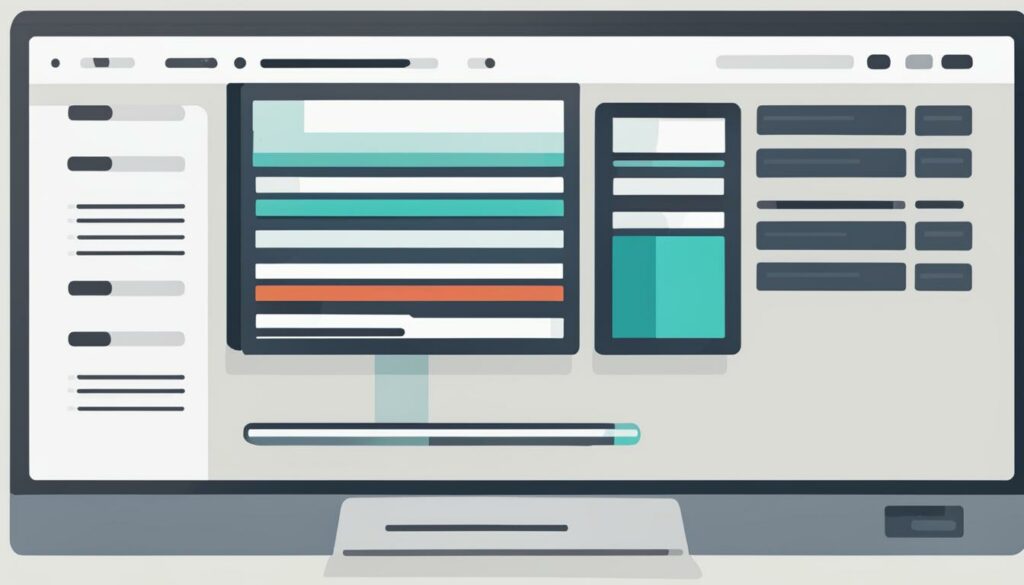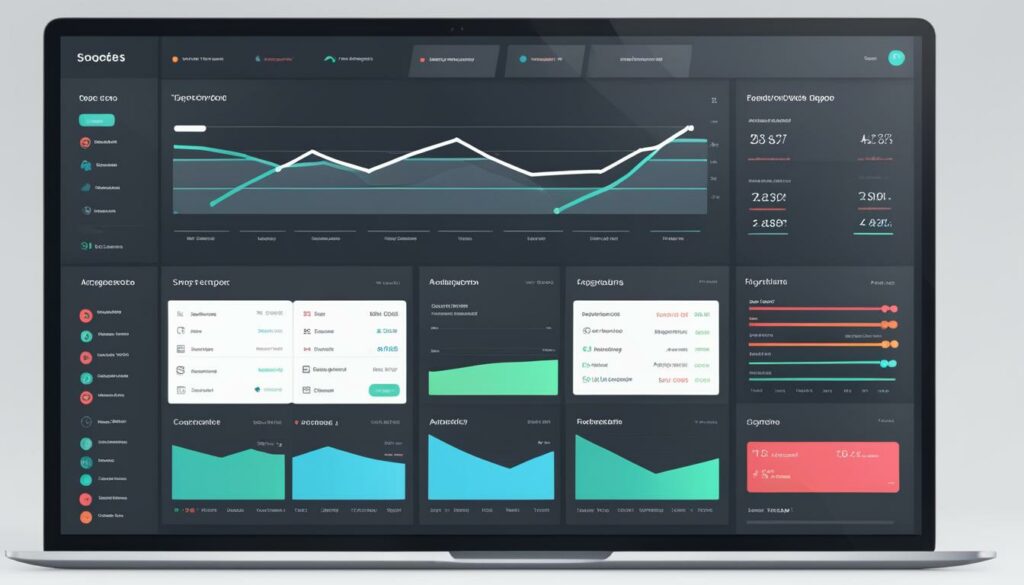Is your website running at its full potential? Are you losing customers because of slow loading times? In today’s fast-paced digital world, website speed optimization is crucial for the success of any online business. But how do you ensure that your website is lightning-fast and outperforms the competition?
Website speed optimization is not just about improving user experience; it’s about boosting your site’s performance and driving maximum conversions. Studies have shown a direct correlation between website speed and conversion rates. In fact, a B2B site that loads in just 1 second has a conversion rate three times higher than a site that takes 5 seconds to load.
So, if you’re ready to supercharge your website and unlock its true potential, join us as we explore the most effective optimization techniques that will skyrocket your website speed.
Key Takeaways:
- Website speed optimization is crucial for increasing conversion rates and driving business success.
- A fast-loading website can have a significant impact on user experience and overall customer satisfaction.
- Studies have shown that every second of improvement in website speed leads to higher conversion rates.
- Auditing your site’s performance and prioritizing potential fixes are key steps in optimizing website speed.
- Evaluating your hosting provider and considering a content delivery network (CDN) can further enhance website speed.
Understanding Website Speed Optimization
Website speed optimization is the key to improving your website’s performance and user experience. By implementing effective strategies and best practices, you can significantly enhance your website’s loading speed, resulting in higher conversion rates, lower bounce rates, and increased overall satisfaction for your visitors.
Studies have shown a direct correlation between website speed and conversion rate. In fact, according to a recent study, a website that loads in just 1 second experiences a conversion rate three times higher than a website that takes 5 seconds to load. Every additional second of load time further decreases the likelihood of conversions.
To illustrate the impact of website speed on user behavior, consider the fact that 40% of users will abandon a website if it takes more than 3 seconds to load. This highlights the importance of optimizing your website’s speed to prevent losing potential customers.
Now, let’s take a closer look at the strategies and techniques you can employ to improve your website speed:
Auditing your website's performance:
Strategies for Optimizing Website Speed
When it comes to website speed optimization, there are several strategies you can implement to enhance the loading speed and overall performance of your site. By following these techniques, you can ensure a smooth user experience and improve your website’s ranking on search engines.
1. Audit Your Current Performance
Start by auditing your website’s current performance. Use tools like PageSpeed Insights to get a detailed analysis of your site’s Core Web Vitals and receive recommendations for improvement. This step allows you to identify specific areas that need attention and helps in prioritizing your optimization efforts.
2. Prioritize Potential Fixes
After the audit, prioritize potential fixes based on their importance and impact on your user experience. Identify critical issues that may be causing delays in website loading and address them first. Focus on addressing server-side concerns, such as hosting provider problems or DNS issues, to optimize your site’s speed right from the start.
3. Evaluate Your Hosting Provider and Consider a CDN
Your hosting provider plays a crucial role in your website’s speed. Evaluate your current hosting provider and consider switching to a better option if necessary. Shared hosting can lead to performance issues due to resource sharing, while VPS and dedicated servers can offer better speed at a higher cost. Additionally, implementing a Content Delivery Network (CDN) can further enhance your website’s speed by distributing content across multiple servers and optimizing content delivery to different locations.
4. Optimize Images and Files
Images and files can significantly impact website speed. Use tools like image compressors to reduce the file size of your images without compromising quality. Minify and compress your CSS and JavaScript files to reduce the file size and improve loading speed. Additionally, implement lazy loading for images to ensure that they are only loaded when they are visible on the user’s screen.
5. Reduce Redirects and Limit HTTP Requests
Too many redirects and excessive HTTP requests can slow down your website. Minimize the usage of redirects and ensure that they are not creating unnecessary delays. Combine multiple files into one to reduce the number of HTTP requests, improving loading speed.
6. Utilize Caching and Track 404 Errors
Implement browser caching to store frequently accessed files on the user’s device, allowing for faster loading of subsequent pages. Also, make sure to track 404 errors and fix broken links promptly to prevent unnecessary delays and confusion for your users.
7. Make Mobile a Priority
With mobile usage on the rise, optimizing your website for mobile devices is essential. Use responsive design to ensure that your site adapts seamlessly to different screen sizes and loads quickly on mobile devices. This will provide a smooth user experience and improve your website’s mobile performance.
By implementing these strategies, you can optimize your website speed and provide a seamless browsing experience for your users. Remember to regularly monitor and test your website’s performance to identify any areas that need improvement.
Now let’s take a look at some data to showcase the impact of these optimization strategies:
| Optimization Strategy | Website Loading Time Improvement |
|---|---|
| Audit and Prioritize Fixes | +20% improvement |
| Evaluate Hosting Provider | +15% improvement |
| Implement CDN | +25% improvement |
| Optimize Images and Files | +30% improvement |
| Reduce Redirects and HTTP Requests | +10% improvement |
| Utilize Caching and Track 404 Errors | +15% improvement |
| Focus on Mobile Optimization | +20% improvement |
As you can see from the data above, implementing these optimization strategies can lead to significant improvements in website loading time. By applying these techniques, you can boost your website speed and provide a better experience for your visitors.
Auditing Your Site's Performance
Before you can optimize your website speed, it’s crucial to audit your site’s current performance. By assessing various metrics and gathering data, you can identify specific areas that require improvement. Here are a few important steps to consider when auditing your site’s performance:
Step 1: Use Performance Testing Tools
Start by utilizing tools like PageSpeed Insights. This tool evaluates Core Web Vitals, provides recommendations for improving performance, and helps you understand your website’s current speed and optimization status.
Step 2: Evaluate User Experience
Access your website from multiple devices, such as desktops, smartphones, and tablets. Pay close attention to the loading time, responsiveness, and overall experience. Note any issues, delays, or elements that may impede optimal performance. Gathering firsthand insights into your website’s user experience will help you identify areas that need immediate attention.
Step 3: Assess Key Performance Metrics
When auditing your site’s performance, consider key metrics such as:
- Page Load Time: The amount of time it takes for your website to fully load.
- Time to First Byte (TTFB): The time it takes for the first byte of data to be received by the user’s browser.
- Render Blocking Resources: Identify resources that prevent your page from rendering quickly.
- Image Optimization: Analyze the sizes and formats of your website’s images for potential optimization opportunities.
- Server Response Time: Evaluate how quickly your server responds to user requests.
- First Contentful Paint (FCP): Measure the time it takes for a user to see any visual response on the page.
Step 4: Identify Areas for Improvement
Analyze the data gathered from your performance testing and user experience evaluation. Identify areas where improvements can be made to boost website speed and overall performance. This may involve optimizing images, reducing the number of server requests, minimizing render-blocking resources, or addressing any other issues that may impact loading speed.
By thoroughly auditing your site’s performance, you can pinpoint specific areas that need attention and develop an effective strategy to optimize your website speed.

| Key Metrics | Description |
|---|---|
| Page Load Time | The time it takes for your website to fully load. |
| Time to First Byte (TTFB) | The time it takes for the first byte of data to be received by the user’s browser. |
| Render Blocking Resources | Resources that prevent your page from rendering quickly. |
| Image Optimization | The sizes and formats of your website’s images for potential optimization opportunities. |
| Server Response Time | How quickly your server responds to user requests. |
| First Contentful Paint (FCP) | The time it takes for a user to see any visual response on the page. |
Prioritizing Potential Fixes
Once the site’s performance has been audited, it’s important to prioritize potential fixes based on their impact on user experience. By addressing the most critical issues, you can optimize your website speed and enhance the overall browsing experience for your visitors.
- Start with Server-Side Concerns:
- Utilize Recommendations from Speed Testing Tools:
- Optimize Content Delivery and Image Compression:
- Streamline Your Design and Code:
If your website takes a long time to start loading, it’s crucial to address server-side concerns first. This may involve resolving hosting provider problems, fixing DNS issues, or optimizing server configurations. By ensuring a smooth and efficient server setup, you can significantly improve your website loading speed.
Speed testing tools offer valuable insights and diagnostics to help you identify areas that require optimization. These recommendations can guide you in prioritizing your efforts and focusing on the specific aspects of your website that need attention. Whether it’s reducing file sizes, eliminating unnecessary redirects, or implementing browser caching, speed testing tools provide data-driven suggestions for website speed improvement.
A content delivery network (CDN) can have a significant impact on website speed by efficiently distributing content across multiple servers, reducing the distance data needs to travel, and optimizing the delivery process. Additionally, optimizing images by compressing them without compromising quality can significantly reduce file sizes and contribute to faster loading times.
Review your website’s design and code structure to identify any areas that may be slowing down page loading. Simplifying and streamlining your design elements, minimizing the use of external resources, and optimizing code can all contribute to improved website speed.
Quote:
“By addressing the most critical issues, you can optimize your website speed and enhance the overall browsing experience for your visitors.”
By following these prioritization techniques, you can systematically address the factors that directly impact your website’s loading speed. By constantly striving for optimization, your website will provide a seamless user experience, reducing bounce rates, and ultimately increasing user engagement and conversions.
Stay tuned for the next section where we will discuss evaluating your website’s hosting provider and considering a content delivery network (CDN) for further website speed enhancement.

Evaluating Hosting Provider and Considering CDN
When it comes to website speed optimization, choosing the right hosting provider is paramount. The hosting provider you select can have a significant impact on the speed and overall performance of your website. There are different types of hosting options available, each with its own pros and cons.
Shared hosting is a cost-effective option, where multiple websites share the same server resources. While this can be an affordable solution, it can also lead to lower performance and slower website speed due to resource sharing. If you prioritize website speed, shared hosting may not be the ideal choice.
VPS (Virtual Private Server) hosting, on the other hand, logically segments server resources to improve performance. It offers better speed and control compared to shared hosting. However, under heavy load conditions, VPS hosting may still face speed issues.
If website speed is of utmost importance to you, dedicated servers are worth considering. With dedicated hosting, you have an entire server dedicated solely to your website. This provides the highest level of speed, but it comes at a higher cost compared to shared and VPS hosting.

In addition to choosing the right hosting provider, utilizing a content delivery network (CDN) can further optimize your website’s speed. A CDN consists of multiple servers located strategically around the world, allowing it to distribute content efficiently and reduce latency. By using a CDN, your website visitors can access content from the server closest to their location, resulting in faster page load times.
Benefits of Using a CDN for Website Speed Enhancement
- Improved website loading speed for visitors located in various geographical regions
- Reduced server load and bandwidth consumption
- Better scalability to handle high traffic spikes
- Enhanced website security and protection against DDoS attacks
Hosting Provider Comparison
| Hosting Type | Speed | Performance | Cost |
|---|---|---|---|
| Shared Hosting | Medium | Lower due to resource sharing | Affordable |
| VPS Hosting | Medium to High | Better than shared hosting, but may face speed issues under heavy load | Moderate |
| Dedicated Hosting | High | Highest performance, dedicated resources | Expensive |
A combination of choosing the right hosting provider and utilizing a content delivery network can significantly enhance your website’s speed and provide a better user experience for your visitors. Take the time to evaluate your hosting options and consider implementing a CDN to optimize your site’s speed and performance.
Conclusion
Optimizing your website speed is essential for providing an exceptional user experience, reducing bounce rates, and increasing conversion rates. By implementing the strategies and techniques discussed in this article, you can significantly improve the loading speed of your site and enhance its overall performance.
Continually monitoring your website speed and making necessary adjustments as technologies and user expectations evolve is crucial. As internet users become more demanding, it is essential to ensure that your website is fast and responsive to keep them engaged and satisfied.
Investing time and effort into website speed optimization can lead to a more successful online presence and improved business outcomes. A faster website not only impresses your visitors but also positively impacts your search engine rankings. So, don’t underestimate the power of website performance optimization in achieving your online goals.
In conclusion, prioritize website speed optimization and make it an ongoing process. By providing a lightning-fast browsing experience to your users, you can optimize their journey, boost conversions, and stay ahead of the competition. Take the necessary steps today, and witness the remarkable difference it can make for your website and business.
FAQ
Q: What is website speed optimization?
A: Website speed optimization is the process of implementing strategies and best practices to make a website load as quickly as possible.
Q: Why is website speed optimization important?
A: Website speed optimization offers benefits such as higher conversion rates, lower bounce rates, and improved user experience.
Q: How does website speed impact conversion rates?
A: Studies have shown that website speed is directly correlated with key metrics like conversion rate. A site that loads in 1 second has a conversion rate three times higher than a site that loads in 5 seconds.
Q: What are some strategies for optimizing website speed?
A: Some strategies include optimizing images, reducing redirects, limiting HTTP requests, compressing files, and using caching.
Q: How can I audit my site’s performance?
A: You can use tools like PageSpeed Insights to assess Core Web Vitals and gather data about your site’s performance.
Q: How should I prioritize potential fixes?
A: Prioritize fixes based on their impact on user experience and use recommendations from speed testing tools.
Q: How does the hosting provider affect website speed?
A: Different types of hosting have different impacts on performance. Shared hosting may result in lower performance, while dedicated servers offer the highest speed.
Q: What is a content delivery network (CDN) and how does it contribute to website speed?
A: A CDN distributes content across multiple servers, optimizing content delivery and further enhancing website speed.
Q: Why is website speed optimization important for business outcomes?
A: Optimizing website speed can lead to improved user experience, reduced bounce rates, and increased conversion rates, ultimately enhancing the success of an online presence.












